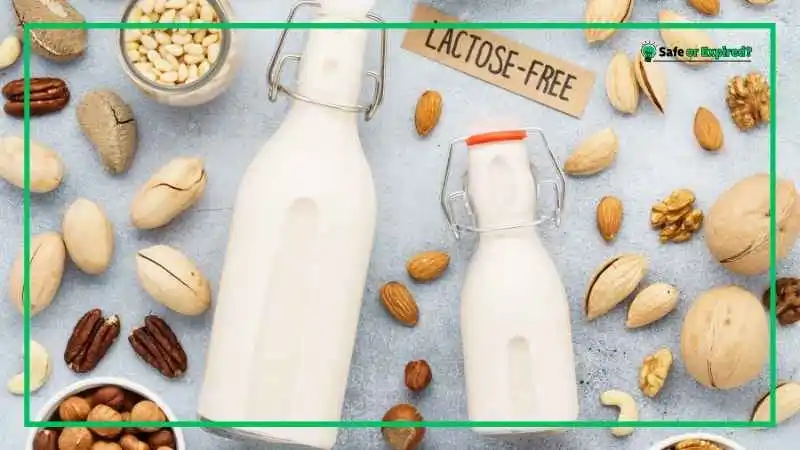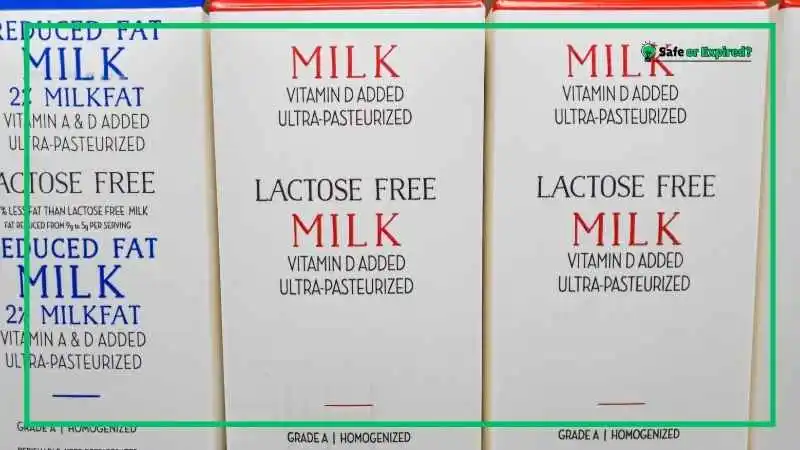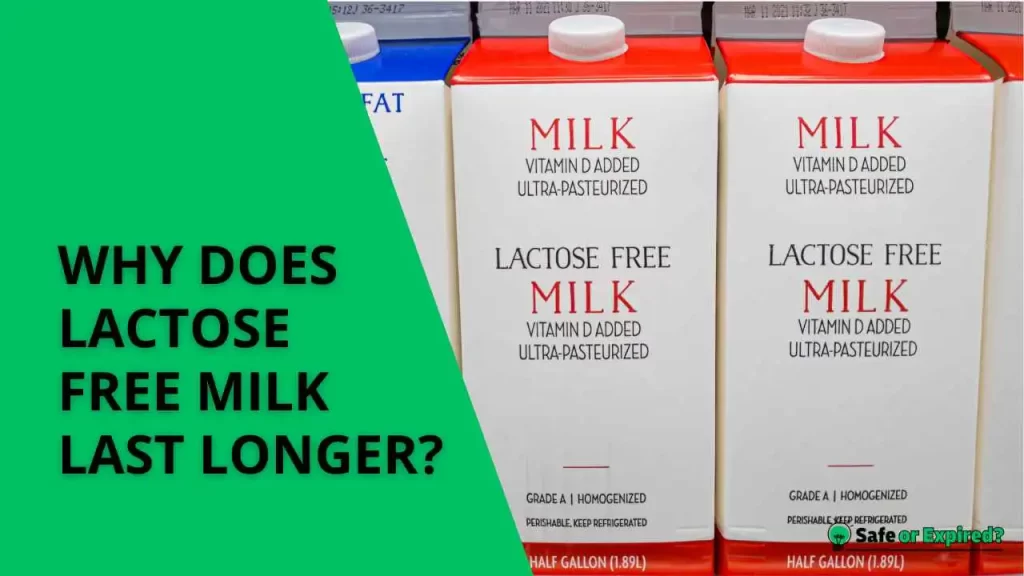“Why does lactose-free milk last longer?” is a relevant topic for food bloggers. Well, the reasons are interesting. It lasts longer because it undergoes ultra-pasteurization and lacks lactose, which slows bacterial growth. Keep reading to uncover the fascinating details, including what will happen if you drink the expired lactose-free milk.
Why Does Lactose Free Milk Last Longer? 3 Logical Reasons
Lactose-free milk lasts longer than regular or lactose milk because it undergoes a process called ultra-pasteurization. This method heats the milk to a higher temperature than standard pasteurization, effectively killing more bacteria and extending its shelf life. Additionally, the absence of lactose prevents the growth of certain bacteria that spoil milk.
Ultra-Pasteurization Process
Ultra-pasteurization heats milk to a higher temperature than regular pasteurization. This process kills almost all the bacteria, making the milk safer and increasing its shelf life. Regular pasteurization heats milk to about 161°F for 15 seconds.
In contrast, ultra-pasteurization heats milk to 280°F for at least 2 seconds. This higher temperature kills more bacteria and enzymes that can spoil the milk.
Because of this, ultra-pasteurized milk can stay fresh for much longer when unopened. This method is common for lactose-free milk to ensure it lasts longer, even though it changes the taste slightly. Despite this change, many people prefer the extended shelf life and safety it provides.
Reduced Bacterial Growth
Lactose-free milk also lasts longer because it contains less lactose. Lactose is the sugar in milk that many bacteria feed on. By removing or breaking down this sugar, there is less food available for bacteria, which slows their growth.
Most lactose-free milk has lactase added to it. It is an enzyme that breaks down lactose into simpler sugars, which are easier for people with lactose intolerance to digest. With less lactose present, fewer bacteria can grow, meaning the milk spoils more slowly.
This reduction in bacterial growth is another reason why lactose-free milk can stay fresh for longer, providing an extended shelf life compared to regular milk.
Improved Storage Conditions
The packaging and storage of lactose-free milk also play a role in its longer shelf life. Often, lactose-free milk is stored in airtight, light-blocking containers. This type of packaging helps protect the milk from light and air.

Keeping the milk in a cool place also helps maintain its freshness. Refrigeration slows down the growth of any remaining bacteria, extending the milk’s shelf life even further. These improved storage conditions, combined with the ultra-pasteurization process and reduced lactose content, help keep lactose-free milk fresh for a longer time.
How Long Does Lactose-Free Milk Last?
Lactose-free milk generally lasts about 7-10 days after opening when stored properly in the refrigerator at or below 40°F (4°C). Unopened, the lactose-free milk can last until the expiration date printed on the packaging. Lactose-free milk can last even longer if it has preservatives and extra vitamins.

People often ask, “How long does lactose-free milk last in the fridge?” Lactose-free milk, when stored in the refrigerator at or below 40°F (4°C), can last up to 7-10 days after opening. If the container remains unopened, it can last until the expiration date indicated on the bottle/packaging.
You may be wondering, “How long does lactose-free milk last out of the fridge?” Lactose-free milk should not be left out of the fridge for more than 2 hours.
Here’s a shelf life table of Lactose-Free Milk:
| Condition | Duration |
| Unopened, refrigerated | Until the expiration date |
| Opened, refrigerated | 7-10 days |
| After expiration, refrigerated | A few days (check for spoilage) |
| Out of the fridge | Up to 2 hours |
How Long Does Lactose-Free Milk Last After Expiration?
Lactose-free milk can sometimes last a few days past its expiration date if it has been consistently refrigerated and shows no signs of spoilage. However, it is generally recommended to consume it by the expiration date for the best quality and safety.
Always check for any spoilage indicators, such as a sour smell, before using milk that is past its expiration date.
What Happens if You Drink Expired Lactose-Free Milk?
Drinking expired lactose-free milk can lead to food poisoning, causing symptoms like stomach cramps, diarrhea, vomiting, and nausea. The severity depends on how spoiled the milk is and individual tolerance. If the milk has a sour smell or off taste, it’s best to avoid consuming it to prevent illness.
Stomach Discomfort
One of the most common side effects of drinking expired lactose-free milk is stomach discomfort. This can include feelings of nausea, stomach cramps, and bloating. When milk spoils, it develops bacteria that can irritate your stomach. This can lead to unpleasant feelings and make you regret drinking the spoiled milk.
Diarrhea
Another side effect of consuming expired lactose-free milk is diarrhea. Spoiled milk contains harmful bacteria that can upset your digestive system. These bacteria can cause your body to expel the spoiled contents quickly, leading to diarrhea.
This can be uncomfortable and may last for a few hours to a day, depending on how much spoiled milk you drank and how sensitive your stomach is.
Vomiting
Vomiting is another possible reaction to drinking expired lactose-free milk. If your body detects harmful bacteria or toxins, it may try to get rid of them by making you vomit. This is your body’s way of protecting you from getting sicker.
Vomiting can be quite unpleasant and may leave you feeling weak and tired afterward.
Bad Taste and Smell
Lastly, expired lactose-free milk will have a bad taste and smell. Even before experiencing stomach discomfort, the sour or off-taste can be a clear sign that the milk has spoiled. The smell may be sour or unpleasant, which is a good indicator that you should not drink it.
So, always check the milk’s smell and taste before drinking it to avoid these unpleasant reactions.
How To Tell if Lactose-Free Milk Is Bad? All the Signs
To tell if lactose-free milk is bad, check for a sour smell, off taste, and curdled texture. Look for any changes in color or consistency. If the milk has been stored past its expiration date or hasn’t been refrigerated properly, it’s best to discard it.
Sour Smell
One of the first signs that lactose-free milk has gone bad is a sour smell. Fresh milk should have a neutral, slightly sweet scent. If you notice a strong, sour odor when you open the container, the milk has likely spoiled.
This sour smell is caused by bacteria breaking down the milk, producing lactic acid which has a strong, unpleasant odor.
Thick Texture
Another clear sign of spoiled lactose-free milk is its thick or clumpy texture. Fresh milk is smooth and liquid. When it goes bad, it can become thicker and may form clumps. You might see these clumps floating in the milk or feel the difference when you pour it. If the milk doesn’t flow smoothly, it’s a good indication that it’s no longer safe to drink.
Strange Taste
The taste of the milk can also tell you if it’s spoiled. Fresh lactose-free milk should taste clean and slightly sweet. If you take a sip and notice a sour or off-taste, it means the milk has gone bad. The sour taste comes from the same bacteria that cause the sour smell.
If the taste is unpleasant or different from usual, it’s best to stop drinking it and dispose of the milk.
Expiration Date
Lastly, always check the expiration or EXP date on the container. While the date isn’t a guarantee, it’s a good guideline for how long the milk should stay fresh. If the milk is past this date, there’s a higher chance it has spoiled. However, even if it’s before the expiration date, use other signs like smell, texture, and taste to judge if the milk is still good.
Comparing the Shelf Life of Different Milk Types
Different types of milk have varying shelf lives due to their processing methods. Regular milk lasts 1-2 weeks, lactose-free milk lasts 1-2 months, ultra-pasteurized milk lasts 2-3 months, and shelf-stable milk can last up to 6 months when unopened.
| Milk Type | Shelf Life (Unopened) | Shelf Life (Opened) |
| Regular Milk | 1-2 weeks | 5-7 days |
| Lactose-Free Milk | 1-2 months | 7-10 days |
| Ultra-Pasteurized | 2-3 months | 7-10 days |
| Shelf-Stable Milk | Up to 6 months | 7-10 days |
Regular Milk
Regular milk is usually pasteurized, which means it’s heated to 161°F for 15 seconds to kill most bacteria. This process gives it a shelf life of about 1-2 weeks when unopened and stored in the fridge. Once opened, it should be consumed within 5-7 days to avoid spoilage.
Pasteurization kills many bacteria, but not all, so it doesn’t last as long as ultra-pasteurized or shelf-stable milk.
Lactose-Free Milk
Lactose-free milk undergoes the same pasteurization process as regular milk but often lasts longer due to the removal or breakdown of lactose. Without lactose, there’s less for bacteria to feed on, which slows their growth. Unopened lactose-free milk can last 1-2 months in the fridge.
After opening, it should be consumed within 7-10 days, similar to regular milk.
Ultra-Pasteurized Milk
Ultra-pasteurized milk is heated to a much higher temperature (280°F) for just a couple of seconds. This kills more bacteria and enzymes, giving the milk a longer shelf life of 2-3 months when unopened.
The taste might be slightly different due to the high heat, but it’s safe and stays fresh longer. After opening, it should still be consumed within 7-10 days, just like other types of milk.
Shelf-Stable Milk
Shelf-stable milk, also known as UHT (Ultra-High Temperature) milk, is processed at even higher temperatures and packaged in sterile containers. This makes it last up to 6 months unopened at room temperature.
It’s perfect for keeping in the pantry as a backup. That’s all.
Conclusion
Understanding why lactose-free milk lasts longer can help you make better choices for your fridge. Here’s a quick recap:
- Ultra-pasteurization kills more bacteria.
- Lack of lactose reduces bacterial growth.
- Improved storage conditions enhance freshness.
Choosing lactose-free milk can be a great option for those looking for a longer-lasting dairy product. Now you know the science behind its extended shelf life, making it easier to enjoy fresh milk for longer periods.

